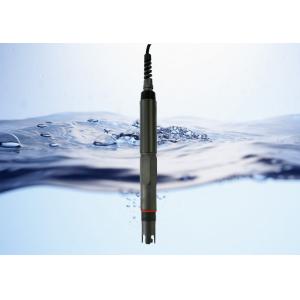

Add to Cart
KFL501 integrated on-line fluoride ion sensor uses a solid membrane ion-selective electrode for testing free fluoride ions in water with temperature compensation to ensure fast, simple, accurate and economical testing. The technical parameters, communication protocols, and maintenance of the fluoride ion sensor are described in detail in this manual.
| Model | KFL501 |
| Measuring range | 0~100mg/L |
| Resolution | 0.01mg/L |
| Accuracy | ±20% or ±1mg/L |
| Working temp | 0~40℃ |
| Working pressure | <0.1MPa |
| pH range of the medium | 5~8 pH |
| Temperature compensation | Automatic temperature compensation (Pt100) |
| Power supply | 12~24VDC ±10% |
| Signal output | RS-485 bus, Modbus/RTU protocol |
| Wetted material | PVC and POM |
| Installation method | PVC and POM |
| Cable length | 5 meters, other lengths can be customized |
| Calibration method | Two-point calibration |
| Power consumption | <0.3W@12V |
| Protection grade | IP68 |
Note: The sensor should not be installed upside down or horizontally when installed, at least at an angle of 15 degrees or more.
a) Red line - power cord (12 ~ 24 V DC)
b) Black line - ground (GND)
c) Blue line - 485 A
d) White line - 485 B
e) Bare wire - shielded wire
After wiring is completed, it should be carefully checked to avoid incorrect connections before powering up.
Cable specification: Considering that the cable is immersed in water (including sea water) for a long time or exposed to the air, the cable has certain corrosion resistance. The outer diameter of the cable is Φ6 mm and all interfaces are waterproof.
The fluoride ion electrode was activated in deionized water for 24 hours prior to use.
The sensing element of the fluoride ion electrode must be cleaned with deionized water and kept dry during storage. If the storage time is more than 8 hours, put a protective cap on the film head. The reference solution of the composite electrode is careful not to be evaporated to cause crystallization. Prior to testing, if the electrode storage time is less than one week, 50 mL of TISAB can be soaked in 50 mL of deionized water. If the storage time is more than one week, the electrode should be cleaned, wiped dry, and placed in the original packaging.
Check if the terminal is dry. If it is stained, wipe it with absolute alcohol and dry it. Avoid long-term immersion in distilled water or protein solution and prevent contact with silicone grease. The electrode is used for a long time. When a measurement error occurs, it must be calibrated with the meter.
When the calibration and measurement cannot be performed while maintaining and maintaining the electrode in the above manner, the electrode has failed. Please replace the electrode.
Note: The sensor has been calibrated before leaving the factory. If it is not beyond the measurement error, it should not be arbitrarily calibrated.
a) Zero calibration
Place the sensor in a vial containing the zero standard solution and wait for 5 minutes. After the value is stable, see if the displayed value is within the error range. If not, perform a zero calibration. Refer to the appendix for calibration instructions.
b) Slope calibration
Place the sensor in a vial containing the standard solution of the slope and wait for 5 minutes. After the value is stable, see if the displayed value is within the error range. If not, the slope calibration is required. Refer to the appendix for calibration instructions.
This product includes:
The company provides local after-sales service within one year from the date of sale, but does not include damage caused by improper use. If repair or adjustment is required, please return it, but the shipping cost must be conceited. Damaged on the way, the company will repair the damage of the instrument for free.
Website www.kacise.com
Phone +86-17719566736
Email sales@kacise.com
Location Tangyan South Road, High-tech Zone, Xi'an City, Shaanxi
Province, China
